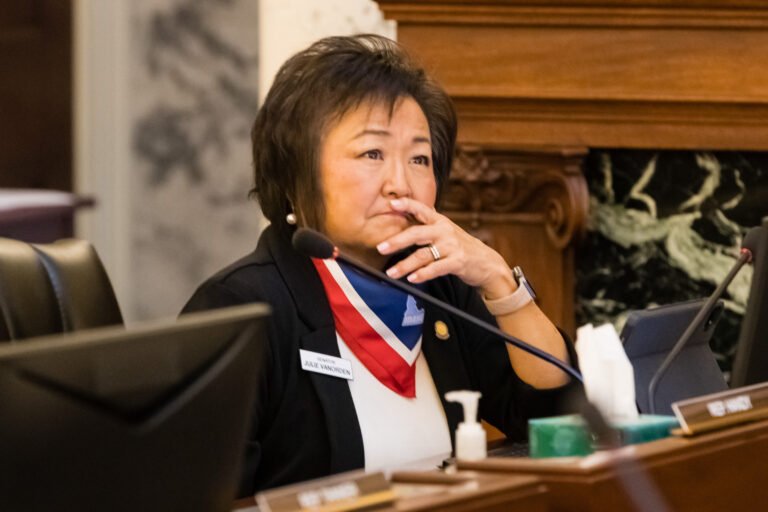Here’s what Idaho legislators are weighing as they plan to set the state’s Medicaid budget
The growing budget for Idaho’s largest program has worried lawmakers, but committee members have different ideas on how to save the state money
Before Idaho legislators adjourn for the year, they have to pass a balanced budget.
And on Friday, the powerful Joint Finance-Appropriations Committee, or JFAC, is set to take up a major piece, as it sets the budget for Medicaid, Idaho’s largest state government program.
JFAC is scheduled to set a raft of other state budgets this week, including for public schools and higher education institutions. Setting the Medicaid budget would come just two weeks before Idaho legislative leaders hope to adjourn the 2024 session on March 29, ahead of elections for all 105 state legislative seats.
Idaho’s Medicaid’s budget narrowly cleared the Legislature last year, passing the Senate by one vote.
Idaho Republican lawmakers have criticized Idaho Medicaid’s ballooning budget, which has grown from less than $3 billion in fiscal year 2020 to around $4.7 billion next fiscal year, if approved. Idaho voters approved Medicaid expansion that took effect in 2020, granting Medicaid coverage to a broader range of low income earners.
Joint Finance-Appropriations Committee Co-Chairman Sen. C. Scott Grow, R-Eagle, listens to proceedings in the budget committee’s hearing room at the Idaho State Capitol building on Jan. 23, 2024.
While some observers say Medicaid’s drastic budget growth has seemed to level off in the past few years, top Republican legislators are still viewing the Medicaid budget with caution.
“This is a freight train that is ever accelerating that’s going to have a problem sometime down the road. The question is what the problem is going to be,” said JFAC Co-chair Sen. Scott Grow, R-Eagle, at a Medicaid budget hearing on Thursday.
‘Different philosophies in the room’ on how to fund Idaho’s Medicaid program
The state pays roughly 30% of Idaho’s Medicaid budget, which is expected to cost the state and federal government $4.3 billion this year after Medicaid gives back some leftover money to the federal and state government. The federal government pays the rest of the roughly 70% of overall Medicaid costs.
Idaho Medicaid’s budget could be $4.7 billion next fiscal year under Gov. Brad Little’s proposed budget.
But Idaho’s federal match dropped by around two percentage points for the next fiscal year. That change “indicates that Idaho’s per capita personal income has done better than most other states over the past three years,” according to Idaho’s budget book.
That has, in part, left Idaho to pick up about $58 million in more costs.
Sen. Julie VanOrden, R-Pingree, who sits on JFAC and chairs the Senate Health and Welfare Committee, told the Idaho Capital Sun on Friday that Medicaid budget talks are heated.
“People are looking at a lot of dollars in there. And there’s a number of different philosophies in the room, as far as who wants to cut, who wants to make minimal cuts and who wants to not make cuts at all. … We’re trying to bring those people together so we can land somewhere where everybody would be comfortable” she said.
Medicaid programs throughout the country are in a “reset year,” Idaho Medicaid Administrator Juliet Charron told the Idaho Capital Sun on Friday.
She pointed to a more than $277 million reversion in combined state and federal tax funds that Idaho Medicaid left unspent and is giving back. But she said she wouldn’t call the Medicaid budget stabilized, saying that Medicaid in recent pandemic years had unordinary conditions — like an influx of extra federal funds and a federal law that blocked Medicaid officials from removing people no longer eligible for Medicaid during the COVID-19 era. States started that process last spring.
“We’re just starting to come into that new normal. So I’m hesitant to say stabilization has been achieved,” Charron said.
Idaho Hospital Association President and CEO Brian Whitlock, in an interview last week, said an early picture of “what normal might look like in the Medicaid budget” is emerging.
“The Medicaid budget, after several years of angst and concern that it was growing out of control, appears to have stabilized and is starting to level off. And we had a number of disruptions over the last couple of years that prevented us from having a level set and knowing what the Medicaid budget should be moving forward,” Whitlock told the Sun.
JFAC member Julie VanOrden, R-Pingree, listens to proceedings in the committee’s hearing room at the State Capitol building on Jan. 23, 2024.
What chances are there to save money in Idaho Medicaid?
Interim Idaho Department of Health and Welfare Director Dean Cameron recommended at the JFAC hearing Thursday that Idaho’s Medicaid program switch to privately-run benefits through a system commonly known as managed care to save funds.
Some of Idaho’s Medicaid benefits are managed that way now, like outpatient mental health care. A legislative committee last year that studied how to save money in Medicaid, possibly through managed care, didn’t conclude if Medicaid should be restructured.
Cameron touted having a handful of statewide managed care providers run Medicaid benefits as the path to saving money in Medicaid. That should involve working with providers and could even involve Idaho’s value-based care providers, he said, in which health providers manage care rather than managed care companies.
“In my mind, that’s the only way that you’re going to be able to control future costs of the Medicaid program,” Cameron said.
But he said cutting non-discretionary funds from Little’s recommended $38 million just “kicks the problem down the road and creates a bigger hole.” And economic shifts could complicate that, he said.
“We all know that when the economy goes down, Medicaid participation goes up,” he said.
Little also recommended $66.8 million to boost provider pay rates, which the Legislature has recently invested in after some rates were left stagnant, the Idaho Capital Sun previously reported.
Rep. Josh Tanner, R-Eagle, said he worried about the economy.
“We know we’re in a recessionary time,” he said.
“I’m just wondering if this is the time to provide those rate increases, or to look at these nondiscretionaries,” Tanner said.
The agency is only seeking 28 new staff, rather than its originally requested 60, but not because they aren’t needed, Cameron said. But Cameron said many of the positions will help generate and save the state money.
Cameron also recommended Idaho pursue a work requirement for Medicaid, which Little’s budget plans also called for. Idaho’s 2019 work requirement request is still listed as pending by the federal government.
House Concurrent Resolution 30, which is headed to the House floor, would seek work requirements and other Medicaid changes.



